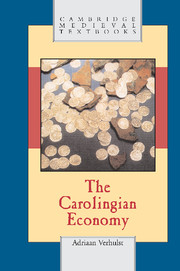5 - Craft and industrial production
Published online by Cambridge University Press: 05 June 2012
Summary
As distinct from the situation in Merovingian times, when some of the artisanal and industrial activities dealt with hereafter took place mostly in an urban context, in Carolingian Europe textiles, tools, weapons and other iron and wooden objects, glass, pottery and salt were manufactured predominantly in a rural and manorial context. The best documented exception to this location is the artisanal quarter, sometimes arranged as a small town (vicus), annexed to or integrated in some big abbeys, like Corbie, St Riquier, St Gall or San Vincenzo al Volturno. Manual workers with diverse specialities such as leather-working, metal-working smiths and weaponmakers, woodturners and other wood-workers and fur-makers had to provide for the needs of very large abbey communities. On the famous groundplan of St Gall abbey (c. 825–30), a large workshop for various crafts is depicted together with a brewery, mills, an officina for fullers and other workshops. In St Riquier the settlement consisted of districts or streets (vici) where the artisans lived together grouped by speciality. Even though the artisans seem to have been more independent than the numerous unskilled provendarii that lived near the abbey as well, they did in fact belong to the unfree or half-free familia of the abbey. It is therefore questionable whether they worked for their own benefit. At San Vincenzo al Volturno, not far to the east of Monte Cassino and on the border of Lombard and Beneventan territories, recent excavations by Richard Hodges brought to light the existence during one generation, up to the 820s, of a builders' yard, where tiles for the basilica roof as well as the floors and roofs of other buildings were made.
- Type
- Chapter
- Information
- The Carolingian Economy , pp. 72 - 84Publisher: Cambridge University PressPrint publication year: 2002



